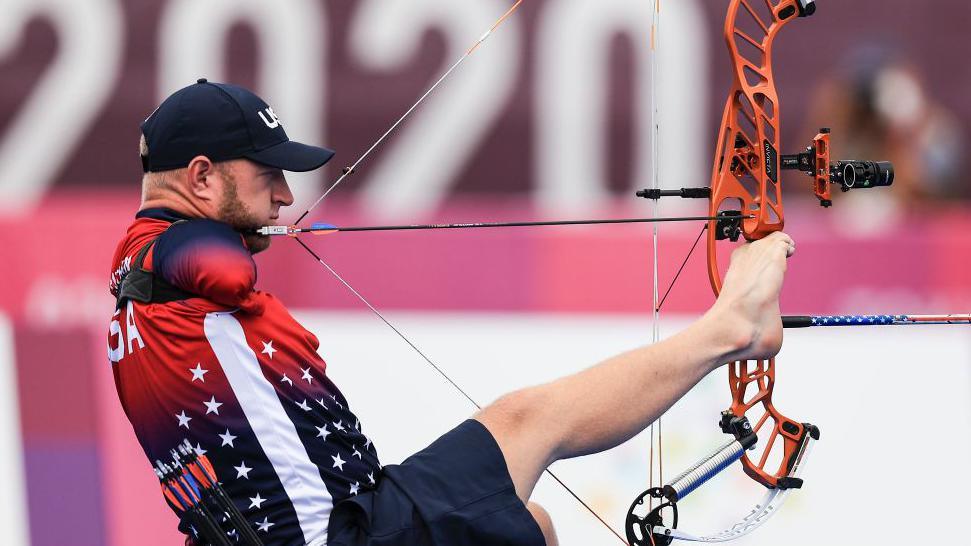Paralympics 2024: A guide to Para-archery at the Paris Games

American Matt Stutzman, who won silver at London 2012, uses his feet to shoot arrows
- Published
Key information
Dates: 29 August-5 September
Venue: Invalides
Gold medals on offer: Nine
What are the rules and classifications for Para-archery?
Archers compete in three classes - W1, open compound and open recurve.
The W1 classification is for the most impaired archers, who may have an impairment in their legs and use a wheelchair. They may shoot either a recurve or compound bow modified from standard rules but there are not separate competitions for the two disciplines.
The open classification is for competitors with an impairment in either the top or bottom halves of their bodies. Some athletes may use a wheelchair but others who have balance issues may shoot resting on a stool or standing.
The recurve bow is the more traditional style of bow - when the string is drawn back, the curves of the bow straighten to give leverage when it is released - while the compound bow uses a system of levers and pulleys in order to fire the arrows.
In W1 competition, the compound bow draw weight is limited to 45lbs and archers are not allowed to use magnifying scopes or levelling bubbles in their sight but competitors in the compound open division can use them and the draw weight is 60lbs.
Targets have a diameter of 122cm and open recurve competitors shoot from a distance of 70 metres while open compound and W1 competitors shoot from 50 metres.
The target is marked with 10 concentric rings which increase in points value the smaller and the closer they get to the centre. A hit in the outermost zone is worth one point while a hit in the centre, the 'gold', is worth 10 points.
Each event includes a ranking round where each archer shoots 72 arrows (12 ends of six arrows each) before the archers enter the elimination rounds.
The winner in the elimination phase in the open compound and W1 events is the athlete who scores the most points across the five ends of three arrows in each head-to-head match. In the open recurve event, the winner is the first archer to score to six points with two points given to the one who gets the highest score over each end of three arrows.
In the event of a tie, an arrow-by-arrow shoot-off will be held, creating the possibility of a gold medal being decided by a single shot.
In the individual events, the top performers in the ranking round will receive a bye in the first elimination round because of the number of entries.
For the team events, teams are ranked according to the combined scores from the ranking round before proceeding to the knockout stages.
Who is in the GB Para-archery squad?
Defending women's compound champion Phoebe Patterson-Pine will be hoping to retain her Tokyo title but among her challengers will be GB team-mate Jodie Grinham, who will be 28 weeks pregnant when she competes in Paris.
Grinham, a team silver medallist in Rio, won the European Para Cup title earlier this year while the GB pair won European Championship bronze in the women's doubles and although that event isn't on the Paralympic programme, they are both in strong form.
Nathan MacQueen is world number two in the men's compound and took silver at the 2023 Worlds as the former rugby player chases a medal at his third Paralympics, while Victoria Kingstone will be hoping to shine in the women's W1 event on her Games debut.
Who are the other challengers?
China led the medal table both at Tokyo 2020 and last year's World Championships in the Czech Republic - although that event had a bigger programme than we will see in Paris.
Having won just one bronze in Tokyo, India is starting to emerge as a strong nation in the sport.
Among their leading challengers is teenager Sheetal Devi, who was born without upper limbs and uses her feet to manoeuvre the bow and shoot arrows. The 17-year-old won world compound silver last year and will be a big threat to Patterson-Pine and Grinham.
David Drahoninsky of the Czech Republic, who will be competing at his fifth Games, will be bidding to continue his record of a medal from each in the men's W1 while former Para skier Kevin Mather will hope to maintain his dominance in the men's recurve, where he is Paralympic and world champion.
Did you know?
Archery was part of the first edition of the Stoke Mandeville Games - the predecessor of the Paralympics. Sixteen injured servicemen and women competed in the event in July 1948 under the supervision of Ludwig Guttmann.
ParalympicsGB Tokyo 2020 medals
Two - one gold (Phoebe Patterson-Pine) and one bronze (Victoria Rumary)